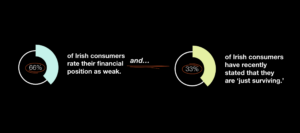April 18, 2023 / Thought Leadership
Mood & Mindset Report April 2023
 At CP, we are always asking “why?” We’re fascinated and ever curious about customer mood and mindset. Here’s a few observations and constructive fodder for discussion from our anthropology and strategic planning teams from this past quarter.
At CP, we are always asking “why?” We’re fascinated and ever curious about customer mood and mindset. Here’s a few observations and constructive fodder for discussion from our anthropology and strategic planning teams from this past quarter.
1. Living With Tech Disruption
An opportunity cloaked in uncertainty.
Observation: In the past few months much has been made of technology entering our lives. Examples include worldwide buzz around generative AI like ChatGPT (and now GPT-4) to new technologies being used in sports in the form of pitch clocks, VR, and data tracking.
In the advertising world, technology like generative AI serves as a potential threat that could marginalize creativity across various competencies. Much is still to be explored and learned.
What brands can do: Always explore – rather than reject – these emerging technologies, viewing them as potential tools rather than automatic threats. Some may come, some may go – however, through exploration, brands and consumers can reap any potential benefits that may be presented to us today and into the future.
Sources: The Atlantic, Forbes, The New York Times & The Good Phight
2. De-influencing & Consumerism
Don’t buy that, buy this instead.
 Observation: Influencer marketing is changing and creators are leaving #TikTokMadeMeBuyIt back in 2022 in favor of #De-influencing in 2023. As ‘eat the rich’ storylines permeate culture, creators and Gen Z are taking advantage of an emergent push against consumption culture. However while the benefits of ‘de-influencing’ are serving negative views of consumerism, people are still being influenced towards other products, highlighting that de-influencing is more of a fun trend and TikTok buzzword due to the media and public’s embracing of the term.
Observation: Influencer marketing is changing and creators are leaving #TikTokMadeMeBuyIt back in 2022 in favor of #De-influencing in 2023. As ‘eat the rich’ storylines permeate culture, creators and Gen Z are taking advantage of an emergent push against consumption culture. However while the benefits of ‘de-influencing’ are serving negative views of consumerism, people are still being influenced towards other products, highlighting that de-influencing is more of a fun trend and TikTok buzzword due to the media and public’s embracing of the term.
What brands can do: For influencers—or brands that are becoming more wary of using influencers—they must consider their communication strategies and continue to avoid inauthentic means of communications and influence due to consumers’ ever increasing demand for authenticity in the content they see.
Sources: AdAge, AdWeek & Business.com
3. Where Have the Customers Gone?
Customers are moving—meaning new markets and realities.
 Observation: Customers are in a state of moving, and major shifts as it relates to where they live, work and shop are continuing to take place in 2023. Many cities, like Boston and Dublin for example, have seen population decreases since the beginning of the Covid pandemic in the spring of 2020. This is, in part, due to economic reasons such as the elevated housing market and cost of living as well as increasing work-from-home or work-from-anywhere flexibility. Lifestyle changes for consumers cause disruption to habits, which means priorities will come into focus, especially with their status quo being transformed.
Observation: Customers are in a state of moving, and major shifts as it relates to where they live, work and shop are continuing to take place in 2023. Many cities, like Boston and Dublin for example, have seen population decreases since the beginning of the Covid pandemic in the spring of 2020. This is, in part, due to economic reasons such as the elevated housing market and cost of living as well as increasing work-from-home or work-from-anywhere flexibility. Lifestyle changes for consumers cause disruption to habits, which means priorities will come into focus, especially with their status quo being transformed.
What brands can do: The shifts in consumers and their environments means that brands may have to rethink how they reach their target customers given new lifestyles and realities, especially during certain periods of their lives like retirement.
Sources: The Boston Globe, The Irish Times, Brookings & CBS News
4. There Are Essentials Within ‘Essentials’
Non-negotiables shouldn’t feel like negotiables.

Observation: 66% of people in Ireland are actively seeking ways to spend less, but acknowledge that they will ultimately end up spending more in the coming months. People across the financial spectrum are adjusting their spending habits, even when it comes to ‘essential’ items. Those under the most pressure are trying to squeeze every ounce from their budget, while those who are better off are still trying to reduce their spending by looking for options that present ‘better value.’
What brands can do: There is an opportunity for brands, products and services across FMCG sectors to cement their position as a ‘non-negotiable’ essential. Brands can do this by leveraging emotional connections and moments that happen during these interactions, illustrating how they are crucial to these personal moments being successful.
Sources: Bord Bia X Canvas8 & Kantar
5. The Next Generation of Free Speech?
People are skirting around topics, we have to follow them.
Observation: Slang comes and goes, often it reflects a moment in time, illustrating what is happening in the world. As the day-to-day changes, so does the colloquial language used. Algospeak feels different though. The reason it exists is different. Algospeak is code or rhyming slang used to avoid moderation or censorship online. True crime content creators will often use the term ‘Unaliving’ when discussing cases – a code for killing or being killed e.g., ‘The suspect was apprehended by police after unaliving his wife.’ It is an attempt to speak freely without being penalized. Separately, Elon Musk is seeking to develop an alternative option to ChatGPT, one that doesn’t ‘penalize conservative biases.’
What brands can do: This matters for brands because while we may not understand or agree with these approaches, people are still actively trying to avoid being moderated. Going forward, brands need to consider these new ‘languages’ in order to maintain relevance and reach intended audiences.
Sources: Twitter, The Information, USA Today & RTE
All good things expire. Look out for more reports coming soon.

 brief us?
brief us?





